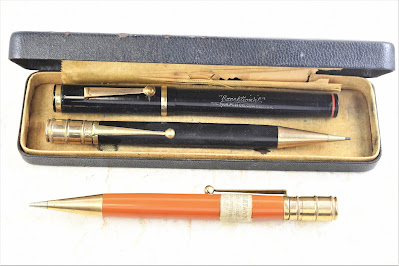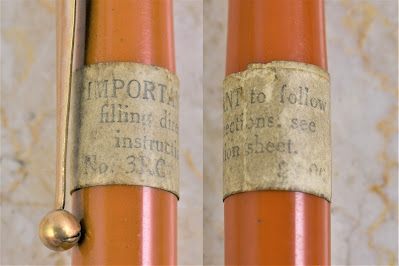This article has been included in The Leadhead's Pencil Blog Volume 7, now available here.
If you don't want the book but you enjoy the article, please consider supporting the Blog project here.
When I started writing yesterday’s article, my intent was to present the complete history of The Pick Pen Company, in the hopes of finding clues as to what the “S.W.P. Co.” means on pencils which are identical to Pick Pencils:
The Charles R. Brandt connection hijacked the story, so today’s installment will lay out the rest of the company’s tragic story, starting with the historically accurate version of the company’s founding: in 1920, salesman Edwin G. Pick and bookkeeper Arthur W. Schoneberger founded the Pick Manufacturing Company at 214 East Ninth Street, Cincinnati, Ohio. Stenographer Ruth C. Weidling was brought over from the Weidlich-Simpson Company to become Pick’s bookkeeper.
The company initially had two foremen: Charles R. Brandt (not the same one who owned the Boston Fountain Pen Company, but likely an nephew or other relative), an independent pen maker in Cincinnati since 1917, was brought in to help the company set up its plant, and the company’s regular foreman going forward was Albert J. Aufdermarsch.
The Pick Manufacturing Company operated at the Ninth Street location, sharing the building with the Victor Brass Company, until November 20, 1922, when fire destroyed the five-story brick building. According to the report published in The Dayton Daily News on November 20, damage was estimated at $50,000, the equivalent of more than $750,000 today:
Accounts don’t specify how the fire started, but note that the occupant is identified as “the Pick Fountain Pen Co.,” not the Pick Manufacturing Company. That might indicate the company was in the process of reorganizing at the time of the fire: in the 1923 directory, Pick Manufacturing is replaced with The Pick Pen Company. Edwin G. Pick was President and Treasurer, Arthur W. Schoneberger was Vice President, and Ruth Weidling was the company Secretary. The firm’s new location was 911 Main Street, Cincinnati:
After moving to the Main Street location, the company began offering mechanical pencils to accompany its pens:
These two were supplied by the Rex Manufacturing Company. The metal ringtop bears McNary’s patent date of February 19, 1924:
The black hard rubber example is also a 1924 McNary patent pencil, but it isn’t marked with the patent date:
By the mid-1920s, Pick had adopted the trade name “Exceptional” to market the company’s writing instruments:
If a trademark application for the “Exceptional” mark was ever filed, registration was never granted. These pencils were also supplied by the Rex Manufacturing Company; they bear the August 4, 1925 and were manufactured pretty close to that date (later production Rex pencils added 1926 patents to the imprints).
The price is no longer legible on the sticker for the Model 3RG, and I’m not sure what was so complicated about filling them:
Edwin G. Pick is still listed as President/Treasurer in the 1925 Cincinnati directory, but prior to the publication of the 1926-1927 directory, he had left the company that would continue to bear his name. In 1926, he is listed as being in the “building specialties” trade at the nearby arcade at 9th and Court Streets:
Ed Pick was replaced as president and treasurer by J. Albert Goldman, who was President and Treasurer of the Cincinnati Electrical Tool Company in 1925. The fact that Goldman was now in charge of both the company and its money (and the fact that the Cincinnati Electrical Tool Company disappears from the Cincinnati directory for 1926-7 suggests that Goldman bought out Ed Pick, and Ed had moved on:
The transfer occurred at a time when security was lax at the Pick Pen Company. On February 9, 1926, the Cincinnati Enquirer reported that on February 6, an 18-year-old named Robert McNulty appeared at the company’s office looking for a job. When he was turned down, he was somehow able to steal the company’s mail, and he was caught trying to cash a check made payable to the company:
Pick Pen’s misfortunes would only get worse. On January 10, 1928, The Cincinnati Enquirer reported that 1,000 pounds of stored celluloid caught fire, and heavy smoke forced the evacuation of the building as fire crews feared an explosion. The initial report was published before the outcome of the fire was determined:
On January 13, the Enquirer reported that the Main Street plant had been “destroyed by fire,” and the Pick Fountain Pen Company had signed a five-year lease to occupy the third floor at 2100 Reading Road, Cincinnati:
The first floor was occupied by a jeweler, but Pick Pen apparently subleased a show window on street level to demonstrate its products. On May 4, 1928, Pick advertised in the Enquirer for a “FIRST CLASS show window demonstrator; handwriting must be good.”
Pick offered during the mid- to late 1920s were flattop pens such as this, advertised in the Hamilton, Ohio Journal News on September 3, 1929:
All of the late 1920s flattop pencils I have found are imprinted with the “Exceptional” name. These were not Rex Manufacturing products, and they bear more than a passing resemblance to Sheaffer pencils. Later events suggest that Sheaffer might have noticed:
The price sticker on the top example, identifying it as Model 10V (V almost certainly for “vest pocket”) did not break my heart when I found it:
The company also offered a flattop stylographic pen called the “Fountpencil.” Here is one shown advertised in The Salem (Ohio) News on September 16, 1931:
The year 1931 was grim for Pick Pen. On February 17, 1931, the Enquirer reported Pick’s third fire, started by an explosion of celluloid stored at the factory. This time, the company had a sprinkler system installed, so the resulting fire was not as catastrophic as the two previous ones. Nevertheless, the resulting smoke and fumes overcame 24 of the company’s employees:
Whatever was left after the fire was destroyed by water just a few days later. On Sunday, February 22, the Enquirer reported that the sprinkler system at Pick gave way, flooding the entire building:
Pick appeared to be making more money from insurance claims than it did manufacturing pens. Yet things were going to become even more suspicious.
In October, 1931, the W.A. Sheaffer Pen Company filed a patent infringement case against the Pick Pen Company, alleging that Pick had violated three of Sheaffer’s design patents, number 78,777 (for the pencil), 78,794 (for the combination pen and pencil), and 78,795 (for the pen). Here is the last of these three:
The lawsuit puzzled me when I first ran across it, since I wasn’t aware of any Pick pens, pencils or combos which even remotely resembled the Sheaffer Balance. Then, as this article was percolating in my mind, my friend John Lincoln posted pictures of this pen – I told him I had to have it for this article, and he agreed:
Yep. That will do it, and I’m sure Sheaffer already had a hair trigger for a patent infringement case, given how much the “Exceptional” pencils shown earlier resembled Sheaffer’s earlier flat top pencils:
The Cincinnati Enquirer reported on November 3, 1931 that Pick Pen had filed an answer denying infringement, but on December 3, 1931 the Associated Press reported that Sheaffer had obtained an injunction against the company. While I didn’t find the AP report in Pick’s hometown newspaper, it was trumpeted in Sheaffer’s backyard, in the December 3, 1931 edition of the Des Moines Register:
Resolution of the infringement litigation was lightning fast. The United States Patent Office Official Gazette reported that Sheaffer’s patents were valid and had been infringed by the Pick Pen Company in a decision rendered on February 18, 1932.
That was it for Pick’s President, J. Albert Goldman, and possibly for the Pick Pen Company. The 1933 Cincinnati directory lists “The Pick Pen Corporation,” with Arthur W. Schoneberger as president. Ruth Weidling is reported as secretary and treasurer, and a new person, H.F. Fenenbock, is listed as vice president:
There are no Fenenbocks listed in the previous edition of the City Directory, and Fenenbock appears nowhere other than in the listings for Pick Pen Company as vice president, with a residence in Chicago. He might also have been one and the same as Henry W. (“Swanee”) Fenenbock, the “natural huckster” and the subject of an article by Len Provisor and Henry Fenenbock (I think a descendant) for The Pennant in 2007, titled “Henry ‘Swanee’ Fenenbock - The Ultimate Pen Man” (the article can also be found online, at http://newpentrace.net/articleLPFenenbock.html). In the early 1930s, Fenenbock was in the Detroit area.
Recalling Nemo’s account of the company’s history from yesterday’s article, Schoneberger’s son had stated that Pick made pens for 13 years beginning in 1920. Pick was still around in 1933, although Sheaffer’s patent infringement victory in 1932 would have added a formidable creditor to the company’s balance sheets. With two (and perhaps three) suspicious fires at the company’s factories, what happened next is perhaps not surprising:
On October 21, 1933, several newspapers, including this account from the Fremont (Ohio) News-Messenger, reported that safecrackers had broken into Pick’s headquarters and blown open two safes, stealing $2,500.00 worth of gold pens.
Think about that: in a company which had suffered three disastrous fires and explosions in its short history, safecrackers used nitroglycerine to open the company’s safes and steal its contents.
Contrary to Nemo’s account, 1933 was not the end of the Pick story. On November 15, 1934, The Shamokin (Pennsylvania) News-Dispatch published an advertisement for Pick’s new “Perpetual” fountain pen:
Note that distinctive rounded top with a wafer-shaped flat disc at the end. That was doubtless a modification made to alter the shape to avoid Sheaffer’s claims on all things round. Also note that the 1934 advertisement offers Pick’s “new” pens as promotional giveaways for trade-in pens, so these might have been made (or modified) by Pick before 1934, but probably after the injunction against Pick issued in December, 1931.
Pick’s “Perpetual” line of writing instruments would include the pencils that started this research project, marked either Pick or “S.W.P. Co.”
Perhaps Sheaffer might be the “S” in “S.W.P.”? The imprint which started this journey, unfortunately, remains a mystery. I found no connections with Weidlich, nor with anyone else. In fact, I’m not even sure that the “P” stands for Pick.
Pick’s last years are undocumented, except for listings in the Cincinnati directories. In 1936, Fenenbock is gone, leaving Schoneberger and Weidling as the only surviving officers:
Incidentally, this squares with the Fenenbock article cited earlier, which states that Fenenbock “landed broke in Los Angeles in 1936.”
The Pick Pen Company vanished by the time the 1938 Cincinnati directory was published. Edwin G. Pick, the man for whom the company was named, left Cincinnati in 1936 for Fort Lauderdale, Florida, where he died on January 12, 1955. Pick’s obituary in The Fort Lauderdale News on January 13 describes him as a building specialist, and makes no mention of his involvement with what had to be the unluckiest pen manufacturer of all time:



































No comments:
Post a Comment